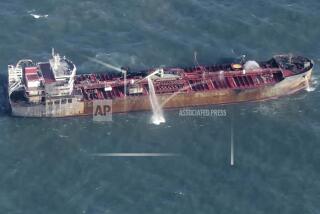Oil Skipper Had Alcohol on Breath, Officer Says
- Share via
VALDEZ, Alaska — A Coast Guard officer smelled alcohol on the breath of the skipper of the Exxon Valdez two hours after the oil tanker ran aground, federal investigators said Wednesday.
But witnesses also reported that Capt. Joseph Hazelwood “seemed to be completely functional, alert and capable,” said William Woody, chief of the four-member National Transportation Safety Board team probing the disaster in Prince William Sound.
Both Hazelwood and the uncertified mate who was commanding the $125-million ship are refusing to cooperate fully with the NTSB investigation, Woody said.
He said the two men were advised by their attorneys not to answer questions about the events leading up to Friday’s shipwreck, which unleashed the worst oil spill in U.S. history.
Meanwhile, the huge slick continued to slosh onto the untamed shores and rocky coves of the sound’s wildlife-rich islands.
Oil was visible over about 575 square miles of the sound, said Jerry Galt of the National Oceanic and Atmospheric Administration, although it is patchy and spreading in irregular fingers.
“The spill is all over Prince William Sound,” Alaska Gov. Steve Cowper said.
Exxon spokesman Don Cornett said the company has hired 300 people to clean up the beaches, but he was unable to say how many crews were actually on the job. Exxon had cleaned up only about 5,000 barrels of the 240,000 to 265,000 barrels that leaked from the ship, Cornett said. Reporters and local fishermen who have visited some of the impacted areas say there appears to be little activity.
‘Good Cooperation’
But Transportation Secretary Samuel K. Skinner reported to President Bush by telephone Wednesday that there was “good cooperation between the various authorities involved,” White House spokesman Marlin Fitzwater said.
Skinner, Environmental Protection Agency chief William K. Reilly and Coast Guard Commandant Paul Yost are due back in Washington from Valdez Thursday and will provide Bush a full report on the situation at that time, Fitzwater said.
“They didn’t have any conclusions to report,” he said, but indicated that “things were more positive than they might have believed.
Alaskan Deputy Atty. Gen. Ron Lorenson arrived in Valdez Wednesday and said he was conducting a criminal investigation of the accident.
The only crewman willing to talk to investigators has been Robert Kagan, who was at the helm, Woody said. He told investigators he received a flurry of orders calling for hard turns just before the tanker went on “a bumpy ride.”
Exxon officials said Hazelwood was not on the bridge when the tanker struck a reef one-half mile outside of established shipping lanes. Third mate Gregory Cousins was giving the orders.
Woody noted that blood-alcohol tests “were taken somewhat late” to give accurate estimates of the sobriety of the four key crew members tested.
Woody said more than nine hours passed between the ship’s grounding on Bligh Reef and administration of the tests, although a urinalysis kit was on board the vessel when a state trooper and a Coast Guard officer boarded the ship at 2 a.m., two hours after the accident.
The Coast Guard officer told the NTSB there was “the smell of alcohol” on Hazelwood’s breath, Woody said.
Woody could not immediately say whether the Coast Guard officer asked Hazelwood if he had been drinking.
Exxon has acknowledged that Hazelwood had a history of drinking problems during his 20-year career with the company.
The NTSB has postponed Tuesday’s scheduled public hearings into the accident for at least several weeks. Woody gave no reason for the delay.
Although no great numbers of oiled birds or marine mammals have turned up, some biologists cautioned that the worst may be yet to come.
Lisa Rotterman, a University of Minnesota biologist who has been studying the sound’s vast sea otter population for six years, expressed concern for their survival.
Based on daily fly-overs of known otter habitats, Rotterman estimated Wednesday that “over 100” of the creatures have been killed by the spill.
She said the oil was heading for critical pupping grounds and rocks where the otters like to sun.
“I expect mortality to be total if those areas are hit,” she said. “There could be terribly severe ramifications to the sea otter population here--possibly its total extinction.”
Rotterman said she had not spotted any dead otters, but added that “oiled otters sink” and only a fraction of those that die will be seen.
“You can assume that most of the sea otters in the oil are dead.”
Sea otters are most vulnerable to the oil because it penetrates their dense pelt and causes hypothermia. Only 10% to 20% of the otter’s pelt needs to be oiled for the animal to die, she said.
She said the sound is home to 10,000 to 12,000 otters.
When the tanker ran aground, another 42 million gallons remained in its tanks. Nearly half was loaded onto the Exxon Baton Rouge, which was being readied to sail early today, and another Exxon tanker stood by to take the rest.
The Seattle Times reported in Wednesday’s editions that the oil
industry consortium operating the Valdez port had cut back its oil spill cleanup resources severely in recent years.
The cutbacks prevented the consortium from acting quickly in the early hours of the spill when it still might have been contained, said James Woodle, retired Coast Guard commander and general manager of the Port of Valdez from 1982 to 1984.
“You can’t clean up everything in 48 hours,” Woodle said. “But you can contain it, and they could have done it with this one if they had the manpower, the initial response.”
More to Read
Sign up for Essential California
The most important California stories and recommendations in your inbox every morning.
You may occasionally receive promotional content from the Los Angeles Times.












